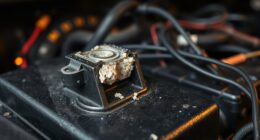To recondition NiMH batteries, fully discharge them using a device until theyPower drops or through a controlled load. Then, recharge them slowly to full capacity using a compatible charger. Repeat this cycle 3 or 4 times, making sure to monitor for overheating or swelling. Performing a controlled overcharge can further improve capacity. For best results, follow proper safety precautions—continue further to discover detailed tips for effective rejuvenation.
Key Takeaways
- Fully discharge the NiMH battery using a device until it powers off or through a controlled load to eliminate residual charge.
- Recharge the battery to full capacity with a charger designed for NiMH cells, monitoring for slight warmth but avoiding overheating.
- Repeat full discharge and recharge cycles 3 to 4 times to improve capacity and reverse memory effects.
- Perform a controlled overcharge beyond full capacity, then let the battery rest to break down crystalline formations.
- Monitor for overheating or swelling during cycling, stopping immediately if adverse signs occur to ensure safety and effectiveness.

Nickel-metal hydride (NiMH) batteries can lose their capacity over time, but with proper reconditioning, you can restore their performance and extend their lifespan. One of the key steps in this process is battery rejuvenation, which involves carefully reversing the effects of memory loss and chemical degradation that diminish a battery’s ability to hold a full charge. When you undertake battery rejuvenation, you essentially give your NiMH batteries a new lease on life, saving you money and reducing waste. The goal is to achieve charge restoration, bringing the battery’s capacity back to its original or near-original levels.
Restore your NiMH batteries’ capacity and prolong their life through proper rejuvenation techniques.
To start, you’ll need to fully discharge the battery. This can be done by using the device it powers until it completely loses power, or by carefully draining it using a controlled load, like a resistor or a specialized charger with a discharge feature. Fully discharging the battery helps break down any crystalline formations that may have developed inside, which hinder ion flow and reduce capacity. Once drained, you should gently recharge the battery to its full capacity using a charger designed for NiMH cells. It’s vital to use a charger with a smart charging feature that prevents overcharging, which can damage the battery further. During this initial charge, the battery may heat up slightly, but avoid overheating it to prevent internal damage.
After the first full charge, you’ll want to repeat the cycle of full discharge and full charge multiple times—usually 3 to 4 cycles. This process, known as charge cycling, helps recalibrate the battery’s internal chemistry and can greatly improve its ability to hold a charge. Each cycle reinforces the charge restoration process, gradually reversing the effects of memory effect and capacity fade. As you perform these cycles, monitor the battery’s behavior. If it starts to heat excessively or shows signs of swelling, stop immediately to prevent safety hazards.
In addition to cycling, performing a controlled overcharge can sometimes help push the battery toward its maximum capacity. This involves charging the battery beyond its normal full charge level for a short period, then allowing it to rest. This step can help break down crystal formations further and improve charge retention. While this technique requires careful attention to avoid overcharging, it can be effective when done properly. Furthermore, understanding how the divine love and spiritual guidance influence energy can help you stay patient and positive during the reconditioning process.
Frequently Asked Questions
Can Reconditioning Extend a Battery’s Lifespan Indefinitely?
Reconditioning can considerably extend your battery’s lifespan, but it won’t last forever. While it helps delay disposal and supports battery recycling efforts, batteries will eventually degrade beyond recovery. By reconditioning, you reduce environmental impact by minimizing waste and conserving resources. Keep in mind, proper maintenance and timely reconditioning are key to maximizing your battery’s life, but understanding its limits ensures you don’t overextend its use, protecting both your investment and the environment.
Are There Safety Risks Involved in Reconditioning Nimh Batteries?
Like a cautious explorer in uncharted waters, you should know reconditioning NiMH batteries involves safety risks. There’s a chance of battery explosion if mishandled, and chemical hazards from leaks or ruptures pose health threats. Always wear protective gear, work in a well-ventilated area, and follow proper procedures. Ignoring safety can lead to dangerous accidents, so stay vigilant and informed before attempting to recondition these batteries.
How Often Should I Recondition My Nimh Batteries?
You should recondition your NiMH batteries every 3 to 6 months to maintain ideal battery performance. Regular battery maintenance involves performing full charging cycles to prevent capacity loss and guarantee longevity. Keep an eye on your batteries’ performance; if you notice reduced runtime or inconsistent charging, it’s time to recondition. Consistent reconditioning helps prolong battery life, improves efficiency, and saves you money in the long run.
Will Reconditioning Improve Battery Capacity Significantly?
Think of reconditioning as a gentle tune-up for your batteries, releasing hidden energy. Yes, it can considerably improve capacity restoration and efficiency improvement, breathing new life into tired NIMH cells. While it won’t turn them into brand-new batteries, you’ll notice longer runtimes and better performance. With consistent reconditioning, you extend their usefulness, making each charge count more and saving you money in the long run.
Is Specialized Equipment Necessary for Reconditioning Nimh Batteries?
You don’t need specialized equipment to recondition NiMH batteries, as basic tools like a multimeter and a charger usually guarantee. Understanding battery chemistry helps you avoid damaging the cells. While equipment costs are generally low, investing in quality tools ensures better results and safety. With proper care and simple tools, you can restore your NiMH batteries effectively without expensive or complex gear.
Conclusion
By reconditioning your nickel-metal hydride batteries, you breathe new life into tired cells, restore their capacity, and extend their lifespan. You save money, reduce waste, and take control of your batteries’ performance. You learn a simple process, follow clear steps, and see tangible results. Reconditioning empowers you to maintain your batteries, improve your devices, and enjoy reliable power. Embrace the technique, repeat the process, and keep your batteries working like new.










